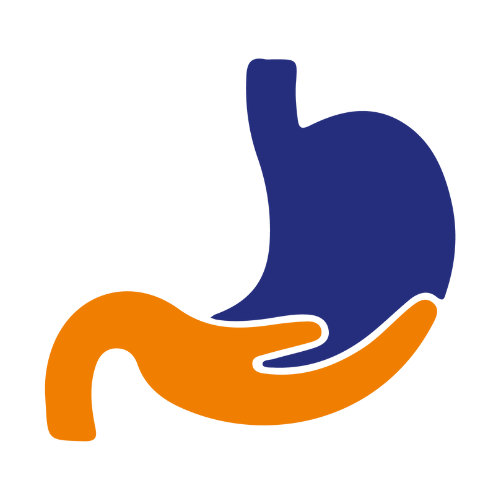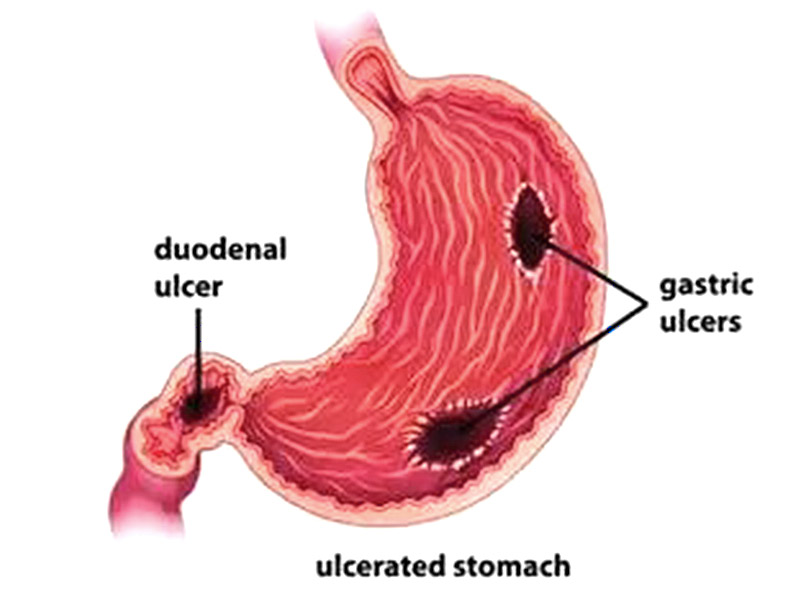Peptic Ulcer Disease
Peptic ulcers are open sores that develop on the inside lining of your stomach and the upper portion of your small intestine. The most common symptom of a peptic ulcer is stomach pain.
Peptic ulcers include:
- Gastric ulcers that occur on the inside of the stomach.
- Duodenal ulcers that occur on the inside of the upper portion of your small intestine (duodenum).
What are the Symptoms?
The most common peptic ulcer symptom is burning stomach pain. Stomach acid makes the pain worse, as does having an empty stomach. Following are the symptom:
- Feeling of fullness, bloating or belching
- Intolerance to fatty foods
- Heartburn
- Nausea
Less often, ulcers may cause severe signs or symptoms such as:
- Vomiting or vomiting blood — which may appear red or black
- Dark blood in stools, or stools that are black or tarry
- Trouble breathing
- Feeling faint
- Unexplained weight loss
- Appetite changes
What are the Causes?
Common causes include:
- Bacterium: Helicobacter pylori bacteria commonly live in the mucous layer that covers and protects tissues that line the stomach and small intestine. Often, the H. pylori bacterium causes no problems, but it can cause inflammation of the stomach’s inner layer, producing an ulcer.
- Regular use of certain pain relievers: Taking aspirin, as well as certain over-the-counter and prescription pain medications called nonsteroidal anti-inflammatory drugs (NSAIDs) , can irritate or inflame the lining of your stomach and small intestine.
- Other medications: Taking certain other medications along with NSAIDs, such as steroids, anticoagulants, low-dose aspirin, selective serotonin reuptake inhibitors (SSRIs), alendronate (Fosamax) and risedronate (Actonel), can greatly increase the chance of developing ulcers.
How is it Diagnosed?
Diagnosis of peptic ulcer disease begins with a comprehensive physical exam. You will be asked about your symptoms and medical history.
Other diagnostic tests your doctor may order include:
Barium contrast radiography (X-ray) or upper gastrointestinal (GI) series are specialized X-rays so your doctor can check for abnormalities. During barium contrast radiography:
- You swallow a contrast solution called barium.
- The barium coats your esophagus and gastrointestinal tract, making it easier for the doctor to detect peptic ulcers.
- An X-ray is taken.
Laboratory tests for H. pylori: Your doctor may recommend tests to determine whether the bacterium H. pylori is present in your body. Doctor may look for H. pylori using a blood, stool or breath test. The breath test is the most accurate.
For the breath test, you drink or eat something that contains radioactive carbon. H. pylori breaks down the substance in your stomach. Later, you blow into a bag, which is then sealed. If you’re infected with H. pylori, your breath sample will contain the radioactive carbon in the form of carbon dioxide.
If you are taking an antacid prior to the testing for H. pylori, make sure to let your doctor know. Depending on which test is used, you may need to discontinue the medication for a period of time because antacids can lead to false-negative results.
Endoscopy: Your doctor may use a scope to examine your upper digestive system (endoscopy). Using the endoscope, your doctor looks for ulcers. If your doctor detects an ulcer, a small tissue sample (biopsy) may be removed for examination in a lab.
Your doctor is more likely to recommend endoscopy if you are older, have signs of bleeding, or have experienced recent weight loss or difficulty eating and swallowing.
What are the Risk Factor?
In addition to having risks related to taking NSAIDs, you may have an increased risk of peptic ulcers if you:
- Smoke: Smoking may increase the risk of peptic ulcers in people who are infected with H. pylori.
- Drink alcohol: Alcohol can irritate and erode the mucous lining of your stomach, and it increases the amount of stomach acid that’s produced.
- Have untreated stress.
- Eat spicy foods.
Alone, these factors do not cause ulcers, but they can make ulcers worse and more difficult to heal.
Left untreated, peptic ulcers can result in:
- Internal bleeding: Bleeding can occur as slow blood loss that leads to anemia or as severe blood loss that may require hospitalization or a blood transfusion. Severe blood loss may cause black or bloody vomit or black or bloody stools.
- A hole (perforation) in your stomach wall: Peptic ulcers can eat a hole through (perforate) the wall of your stomach or small intestine, putting you at risk of serious infection of your abdominal cavity (peritonitis).
- Obstruction: Peptic ulcers can block passage of food through the digestive tract, causing you to become full easily, to vomit and to lose weight either through swelling from inflammation or through scarring.
- Gastric cancer. Studies have shown that people infected with H. pylori have an increased risk of gastric cancer.
How is it Treated?
Several different medication therapies are available to help reduce gastric acid and coat the ulcers:
- Antacids neutralize gastric acid: The disadvantage is that you need to take a relatively large dose for them to be effective, and they can cause unwanted side effects like diarrhea.
- Histamine (H2) blockers reduce gastric acid by blocking the H2 receptors. These medications decrease acid secretion and are a relatively safe treatment option.
- Proton pump inhibitors (PPIs) are drugs that block the three major pathways for acid production. PPIs suppress acid production much more effectively than H2 blockers. PPIs are the gold standard in medication therapy of peptic ulcer disease.
- Medications to protect and strengthen the mucous lining of the stomach
- Antibiotics to treat H. pylori if it is detected

